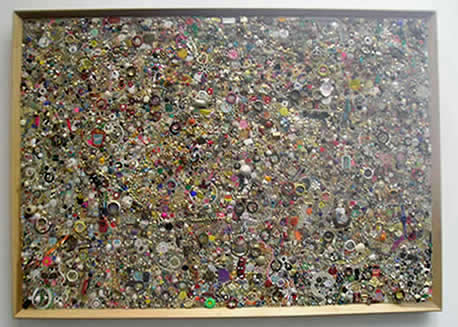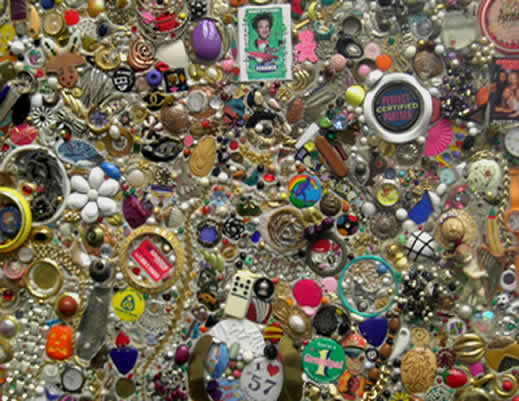Mike Kelley · Biography, Art and works
I clearly remember my first direct contact with the art of Mike Kelley. It happened when I had the opportunity to attend an exhibition featuring the little known and very complete Herbert Collection, which included contemporary masters such as Hans Hofmann, Robert Rauschenberg, Bruce Nauman; and important sculptors like Eduardo Chillida or Sol Lewitt. There, in one of the last rooms, I suddenly faced Kelley’s “Memory Ware Flat #18” (2001). The strength of the work was so overwhelming that it shadowed any other work in the room: the hundreds, perhaps thousands, of pieces of fake jewellery, metal plates, keys, key rings, and other daily objects supposed an exciting challenge for the viewer, taking him to an impossible debate between the possibility of trying to understand the work in its totality, or to the partial contemplation of the multiple and easily recognizable daily life objects. The shocking mixture of cheap, out-fashioned earrings, a few plastic flowers, pins of almost every famous pop band from the 80s, and a funny Flubber pic; was in some sense comparable to the visual extravaganza of a complete set of Quianlong dishes.


Mike Kelley: Memory Ware Flat #18 (2001) Full work and detail
The Herbert collection
It was not easy to me to follow Kelley’s artistic evolution. His works, already present in many American Museums, are really hard to find in European collections. As far as I know, only the Tate Gallery of London seems to have a complete representation of his “The Uncanny” series, and the Centre Pompidou of Paris projected -at the beginning of this year- a series of videos by the American artist in the cycle “Vidéo et après”.
The artistic life of Mike Kelley (Wayne, Detroit, 1954) began in the music world. In fact, Kelley forged the beginnings of his artistic career in the stormy American musical scene of the early 70s, being member of the band “Destroy All Monsters”. Even after moving to Los Angeles, in 1978, Kelley kept his collaboration with the music world, being responsible of the design of the cover and the booklet for the album “Dirty” (1992) by Sonic Youth.

Mike Kelley: Riddle Sphinx (1991)
©The Guggenheim Museum, New York (www.guggenheim.org)
Focusing on visual arts, Kelley is one of those unclassifiable artists whose works show clear influences of the popular culture, which is not strange in an artist raised in the suburban Detroit scene. These influences result in works that are sometimes quite disturbing – from the large, multicolour installations to those strange animal figures or human body fragments- but, however, the rich polychromy used by Kelley gives them an undeniable and strange attractive.
Follow us on:
